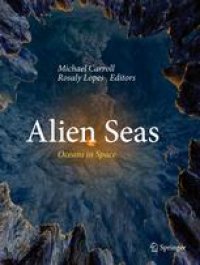
Ebook: Alien Seas: Oceans in Space
Author: Michael Carroll Rosaly Lopes
- Tags: Extraterrestrial Physics Space Sciences, Popular Science in Astronomy, Planetology
- Year: 2013
- Publisher: Springer-Verlag New York
- Edition: 1st
- Language: English
- pdf
Oceans were long thought to exist in all corners of the Solar System, from carbonated seas percolating beneath the clouds of Venus to features on the Moon's surface given names such as "the Bay of Rainbows” and the "Ocean of Storms." With the advent of modern telescopes and spacecraft exploration these ancient concepts of planetary seas have, for the most part, evaporated. But they have been replaced by the reality of something even more exotic. For example, although it is still uncertain whether Mars ever had actual oceans, it now seems that a web of waterways did indeed at one time spread across its surface.
The "water" in many places in our Solar System is a poisoned brew mixed with ammonia or methane. Even that found on Jupiter's watery satellite Europa is believed similar to battery acid. Beyond the Galilean satellites may lie even more "alien oceans." Saturn's planet-sized moon Titan seems to be subject to methane or ethane rainfall. This creates methane pools that, in turn, become vast lakes and, perhaps, seasonal oceans. Titan has other seas in a sense, as large shifting areas of sand covering vast plains have been discovered. Mars also has these sand seas, and Venus may as well, along with oceans of frozen lava. Do super-chilled concoctions of ammonia, liquid nitrogen, and water percolate beneath the surfaces of Enceladus and Triton? For now we can only guess at the possibilities.
'Alien Seas' serves up part history, part current research, and part theory as it offers a rich buffet of "seas" on other worlds. It is organized by location and by the material of which various oceans consist, with guest authors penning specific chapters. Each chapter features new original art depicting alien seas, as well as the latest ground-based and spacecraft images. Original diagrams presents details of planetary oceans and related processes.
In the early days of planetary observation, oceans were thought to exist in all corners of the Solar System. Carbonated seas percolated beneath the clouds of Venus. Features on the Moon's surface were given names such as ''the Bay of Rainbows” and the ''Ocean of Storms.'' With the advent of modern telescopes and spacecraft exploration these ancient concepts of planetary seas have been replaced by the reality of something even more exotic.
Alien Seas serves up the current research, past beliefs, and new theories to offer a rich array of the ''seas'' on other worlds. It is organized by location and by the material composing the oceans under discussion, with expert authors penning chapters on their specialty. Each chapter features new original art depicting alien seas, as well as the latest ground-based and spacecraft images. With the contributors as guides, readers can explore the wild seas of Jupiter's watery satellite Europa, believed similar in composition to battery acid. Saturn's planet-sized moon Titan seems to be subject to methane or ethane rainfall that become vast lakes and, perhaps, seasonal oceans. Titan and Mars have seas of sand, large shifting dunes covering huge plains, while Venus may have ‘oceans’ of frozen lava. The possibilities are excitingly endless and ripe for exploration.
Contributors:
Kevin Baines
Jeffrey Bennett
James Cameron
Michael Carroll
Mona Delitsky
David Grinspoon
Rosaly Lopes
Christopher P. McKay
Karl Mitchell
Robert Pappalardo
Timothy Parker
Jani Radebaugh
John Spencer